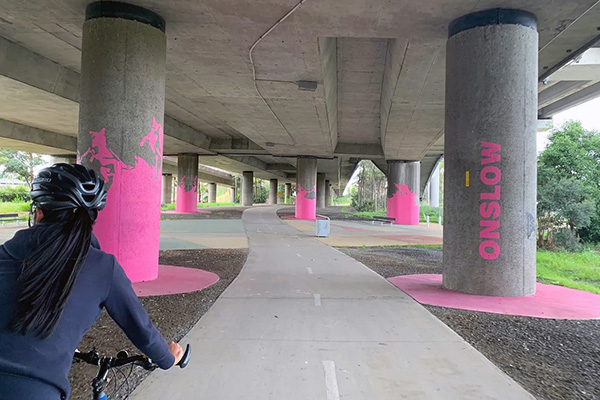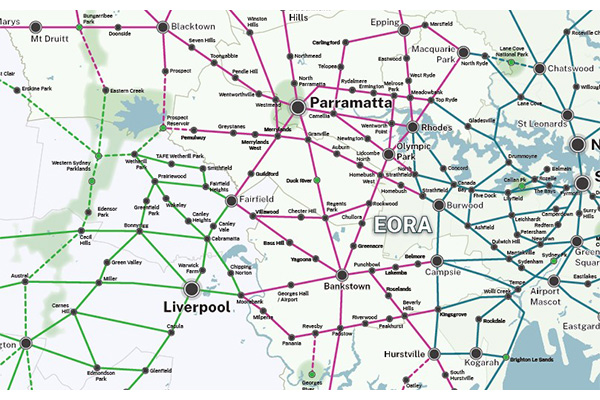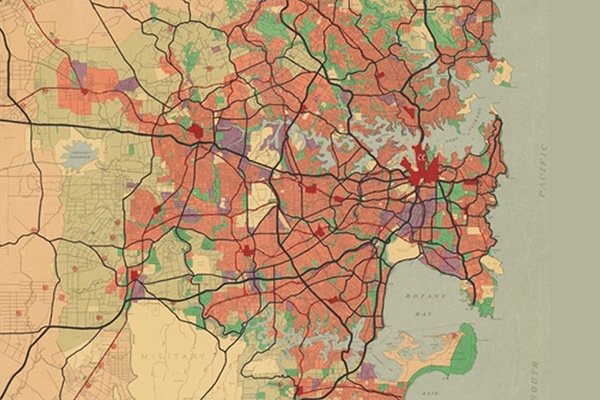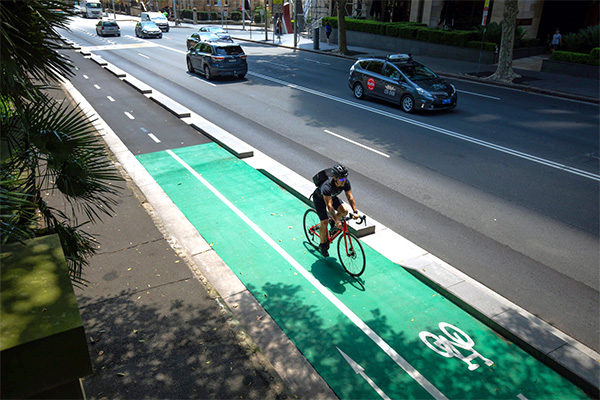Announcements and commitments are coming thick and fast about active transport as the NSW election looms. An exciting moment was the release of networks plans for Strategic Cycleway Corridors for the Central River and Western Parkland Cities.
Bicycle NSW was consulted and we thank the wonderful Bicycle User Group advocates. They spent many hours compiling priority routes across Western Sydney and identifying critical missing links.

The M4 cycleway near Parramatta. The Strategic Cycleway Corridors will focus on efficient and direct connections between activity centres rather than recreational routes (Image credit: Brenden Wood)
The background to the project
Walking and cycling have become much more important to NSW Government in recent years. Even better - we have had a Minister of Active Transport since December 2021! The advocacy team at Bicycle NSW has witnessed a real step change in efforts to integrate walking and cycling into all levels of the planning process.
The new Future Transport Strategy, published in September 2022, clearly shows how the urgent need to move away from ‘car-first’ thinking is becoming more deeply embedded at every level of government. The new Active Transport Strategy draws on the Future Transport Strategy and aims to double walking and cycling trips in 20 years.
One of 5 focus areas is to deliver connected and continuous cycling networks.
The Strategic Cycleway Corridors are intended to be the blueprint for developing 1,000 kilometres of cycleways across NSW. The network for Eastern Harbour City was released in April 2022 and identified 30 strategic cycleway corridors and 250km of new and improved routes.
The Central River City and the Western Parkland City plans add 55 corridors across Sydney. The programme will progressively expand to develop networks for the rest of the 6 Cities Region – Newcastle/Lower Hunter, Central Coast and Illawarra/Shoalhaven.
We are sure our friends and Members have plenty of questions about what the network plans will mean on the ground. And when these safe, continuous ribbons of our dreams may actually be built!
What is the point of the network diagrams?
The maps may look like a series of lines between suburban hubs – not something that required the investment in teams of consultants and dedicated input from experienced advocates.

An extract from the Strategic Cycleways Corridors map for Greater Sydney (Source: TfNSW)
“The strategic corridors plan can be viewed as lacking detail. However, it is a great plan to get stakeholders talking together,” comments Peter McLean, Bicycle NSW CEO. “When local government, State government, utilities and community all talk together on the best cycleway corridor solutions then we will achieve much better strategic planning outcomes.”
It is essential to outline the vision for active transport corridors in the same way as the strategic road or rail network. The Strategic Cycleway Corridors will establish long-term strategies and safeguard connections from competing land uses.

Cumberland Plan was Sydney’s first metropolitan-wide comprehensive planning scheme, dating from 1948. With hindsight we can all look back now and point out shortcomings but the influence of the Cumberland Plan on Sydney’s development was profound. Decisions made decades ago were etched into the mind of generations of planners, and lines on the map showing future roads and railways have become a reality.
(Source: Cumberland County Council, 1951)
The Strategic Cycleway Corridors must reflect an agreed vision for active transport facilities that will be accommodated or delivered by a major infrastructure project. Bicycle NSW will continue to work with all stakeholders to refine the corridors.
We hope that clearly defined corridors on a map will prevent a missed opportunity like that now occurring at Sydney Gateway. Critical cycleways were not included in the design. A possible future connection from the airport to Sydenham has effectively been concreted over by the motorway structure.
Where will the money come from?
Cost estimates are still very vague. Budgets have increased but are insignificant compared with the resources thrown at road projects. Councils are hamstrung and desperately need money, skills and manpower to complete active transport networks and upgrades.
Transport for NSW will use many different levers to fund cycleways. For example, the Providing for Walking and Cycling in Transport Projects policy requires that every project delivered by Transport for NSW must include provision for walking and cycling– this has played out in recent years in projects such as Parramatta Light Rail and the M6 Stage 1.
An expanded Get NSW Active programme will provide grants for local networks. One essential function of the Strategic Cycleway Corridor maps is that council applications for Get NSW Active funding and other grants will be assessed against the ‘blueprint’. Does a proposed piece of infrastructure contribute to the future network? Transport for NSW has a “flying squad” to help councils align with the strategic planning and join the gaps between top-down and bottom-up thinking.
“There are many instances in recent years of poor planning decisions which have rendered bicycle infrastructure either cost prohibitive or not possible. This plan will help prevent some of these mistakes going forward,” says Peter McLean.
Where will the corridors actually be built?
Routes will be subject to detailed design and further collaboration with councils, stakeholders and community.
Important policies that support active transport infrastructure were released in 2021 – Road User Space Allocation policy and Providing for Walking and Cycling in Transport Projects. Transport for NSW promises to apply design guidance from the Cycleway Design Toolbox This recommends not building shared paths where pedestrian and cyclist movements are moderate or high. Narrow and impractical shared paths compromise pedestrian safety and do nothing to challenge the dominance of private vehicles between the kerbs.
The Active Transport team under Minister Stokes has publicly stated that State roads will be used where possible for separated cycleways. This is great as these arterial roads generally provide direct and level routes between activity centres. Cycling and public realm projects will improve amenity on State roads to the benefit of all road users. It also takes the pressure off councils who are faced with balancing complex stakeholder and community demands.

The recently completed separated cycleway on College Street in Sydney uses space reallocated from vehicles to encourage healthy, sustainable transport while reducing noise and emissions.
(Image credit: Chris Southwood/City of Sydney)
Road space reallocation
Sydney’s infamous traffic sewers, where movement has long been prioritised over place, even when they run through neighbourhood centres, fail to move traffic quickly or support local business.
Road space reallocation is essential and will underpin all future transport goals. Space must be taken back from cars to redress 70 years of car-first planning.
As explained in Future Transport Strategy, existing infrastructure must be optimised. NSW cannot keep building roads to ‘solve’ congestion. The focus will be on moving people and goods, not vehicles, recognising that the private car is the least efficient form of transport in terms of space and energy use. Reallocating road space to walking and cycling will help meet objectives around emissions and equity.
Why are existing cycleways missing?
During consultation, we pointed out certain routes that are important to the cyclists that were not included in the preliminary plans. Some have now been added but it is alarming to see cycleways such as the Cooks River, Prospect Canal, M7 and M4 missing from the plans.
Transport for NSW has clarified that the Strategic Cycleway Corridors aim to connect key centres. If an existing route is appropriate, it will be included. However, existing cycleways shouldn’t take priority over delivering the most direct and useful connections. For example, a lot of green grid or paths along waterways do not feel safe at night, limiting their use for transport cycling.
We will continue to interrogate and challenge the project teams on the choice of routes and support the priorities identified by our BUGs.
Will anything happen soon?
Transport for NSW has identified 5 ‘immediate opportunities’ that contribute to important corridors within each of the three cities.
Most ‘immediate opportunities’ align with priorities identified by Bicycle NSW. The connections will fill important gaps in the network and we strongly support the intention to progress with feasibility work.
A good example is the North Sydney Connections between Milsons Point and St Leonards and Neutral Bay, part of the Sydney CBD to Chatswood corridor. The clear lines on the map demonstrate an intention to make this happen, despite the failings of the Warringah Freeway planning to date. A Transport for NSW team is finally attempting to integrate a key strategic cycleway corridor into the project.
However, we are not thrilled that some of the immediate opportunities are concerned with local connections around centres, rather than longer routes between centres. Flagship projects should complete sections of strategic corridors and make a real impact on the regional cycling network.
Next steps
Stakeholders are concerned that the Strategic Cycleway Corridors will go the same way as the Principal Bicycle Network and sit on a shelf once the State elections are over. It is essential that the network plans are embedded in the Six Cities Region Plan that is being developed.
Bicycle NSW will routinely refer to the network plans when asking local and State government to honour the commitment to deliver 1,000 km of safe, connected and continuous cycleways. As our recent submissions show, we add weight to our priorities by linking them to the network plans. Conversely, if proposed road or rail infrastructure impedes the future delivery of an agreed cycleway corridor, we can advocate for a re-think!
“Bicycle NSW will hold stakeholders to account in ensuring that these strategic corridors are both prioritised and preserved into the future,” says CEO Peter McLean. “It is critical that all governments respect and observe these strategic priorities to ensure effective planning outcomes.”
Bicycle NSW will continue to remind TfNSW of its great strategies and policies to prioritise walking and cycling. Please support our advocacy work on active transport infrastructure across NSW by joining the Bicycle NSW family today.

